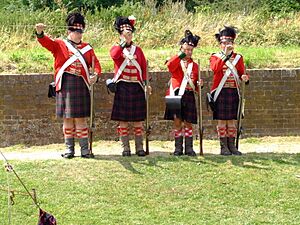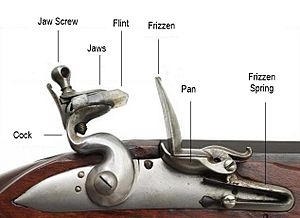Brown Bess facts for kids
The Brown Bess is a famous nickname for a British musket. It was made from 1725 to 1838. This gun, and its different versions, were all .75 caliber smoothbore flintlock muskets. They were the main guns for all land forces in the British Empire.
The Brown Bess was one of the most important military firearms ever designed. It helped the British Empire win many battles. After 1838, newer guns called percussion cap muskets replaced the Brown Bess.
The Brown Bess could shoot effectively up to about 100 yards (91 m). But in most battles, soldiers were only about 50 yards (46 m) apart. Even at that distance, the gun wasn't super accurate. British tactics involved soldiers firing together in volleys. After shooting, they would often charge with bayonets.
No one is completely sure where the name "Brown Bess" came from. One idea is that it came from the German words Braun buss, which means "strong gun." This makes sense because the gun was first ordered when King George I of Great Britain was king, and he was from Germany.
History of the Brown Bess Musket
One of the first types of flintlock muskets used by the English Army was called the "dog lock." It was similar to the snaphaunce. This gun was the first to have a "half-cocked" position for the hammer. This made the gun much safer to handle and load. It was used during the English Civil War. Many of these guns also ended up in the British North American colonies. Another name for the dog lock was the English lock. Some of these old guns have been found by archaeologists at places like Jamestown and Yorktown, Virginia.
Between 1710 and 1720, the first "King's pattern" musket appeared. It was called the “Long Land Service.” This gun had a 46 inches (1,200 mm) barrel. Its metal parts were made of iron, and it used the French lock style of flintlock. Later, the metal parts were changed to brass. Also, the wooden ramrod, which broke easily, was replaced with a stronger iron ramrod.
Around 1722, the British "Long Land Pattern" musket was developed. This gun set a pattern for all arms makers supplying the British Army. This meant all guns would be the same, creating a standard weapon. The Long Land Pattern musket weighed a bit over 10 pounds (4.5 kg) and was 62.5 inches (1,590 mm) long. It had a 46 inches (1,200 mm) barrel and could hold a 17 inches (430 mm) long bayonet. This bayonet was also sometimes used as a simple gunsight.
Around 1756, a second version called the "Short Land Pattern" musket was introduced. Its barrel was shortened to 42 inches (1,100 mm). However, the longer Long Land Pattern continued to be made until 1790.
About 1768, a new "Short Land Service Musket" with a 42 inches (1,100 mm) barrel was made. This was because of the 1768 Clothing Warrant. This rule aimed to make uniforms and equipment lighter for British soldiers. Besides shortening the musket to reduce its weight, soldiers could no longer carry swords (except in special units). Uniforms were also made less bulky. This "Short Land Service Musket" was the gun most used by British forces during the American Revolutionary War. Interestingly, different versions of the Brown Bess were also used by the Continental Army (the American forces).
Musket Drill: How Soldiers Loaded and Fired

To make sure soldiers could load and fire their muskets quickly and safely, the British Army had a strict drill. This drill had many steps that soldiers had to follow in a specific order. Doing these steps correctly and fast was very important in battle. The same drill was also used by the Continental Army in America.
Here's a simplified idea of how soldiers would load and fire their Brown Bess:
- Prepare the Gun: First, the soldier would pull the hammer back to a safe "half-cocked" position.
- Get the Cartridge: They would then take a paper cartridge from their pouch. This cartridge held both the gunpowder and the lead ball. They would bite off the top to open it.
- Prime the Pan: A small amount of powder from the cartridge was poured into a small pan on the side of the gun. This powder would ignite first.
- Close the Pan and Position the Musket: The pan would be shut, and the musket turned to a loading position, usually with the butt on the ground.
- Load the Barrel: The rest of the powder and the lead ball (still wrapped in paper) were dropped into the muzzle (the front end) of the barrel.
- Ram it Down: A long metal rod called a ramrod was used to push the powder and ball all the way down the barrel to the back.
- Return the Ramrod: The ramrod was quickly put back in its place under the barrel.
- Prepare to Fire: The soldier would then bring the musket up, pull the hammer back to the "full cock" position, ready to shoot.
- Aim and Fire: Finally, they would step back, bring the gun to their shoulder, aim, and pull the trigger.
Once the command to "fire" was given, all soldiers would shoot at once. Then, they would quickly repeat the entire drill to reload and fire again. This teamwork and speed were key to how armies fought with muskets.
Images for kids
-
Soldiers of the Black Watch armed with a musket (Brown Bess) and a halberd, circa 1790
-
X-ray of a Brown Bess musket recovered by LAMP archaeologists from an American Revolutionary War-era shipwreck from a ship lost in December 1782. It is believed to be a 1769 Short Land Pattern, and is loaded with buck and ball





